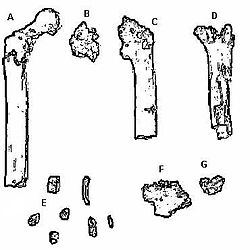Distal-phalanges-comparison-Journal.pone.0011727.g002
Specimens are showed in palmar (top), oblique proximopalmar (middle) and lateral (bottom) views, and scaled to the same length to easily visualize the morphological differences. The main features related to human-like precision grasping are indicated in the middle row, whereas the palmarly protruding insertion for the flexor pollicis longus has been further signaled in lateral view (red arrows in the lower row). Note that, although with several morphological differences, all the features related to refined manipulation in modern humans are already present in the late Miocene Orrorin. By the way, the OH 7 specimen, besides its odd overall proportions, neither shows a distinctive insertion for the flexor muscle, nor a compartmentalized digital pulp. All the phalanges belong to a right thumb. Scale bars represent 5 mm.
Relevante Bilder


Relevante Artikel
OrrorinOrrorin ist eine ausgestorbene Gattung der Menschenaffen, die im oberen Miozän in Kenia vorkam. Ihre fossilen Überreste wurden auf ein Alter von rund 6 Millionen Jahre datiert. Orrorin steht vermutlich den Gattungen Ardipithecus und Sahelanthropus nahe und wird wie diese von vielen Forschern dem Formenkreis der Australopithecinen zugerechnet. Da die Individuen von Orrorin tugenensis vermutlich aufrecht gehen konnten, wurde die Gattung von ihren Entdeckern an die Basis der Ahnenreihe der Hominini gestellt; wegen der wenigen, bruchstückhaften Fundstücke ist dies allerdings umstritten. .. weiterlesen
